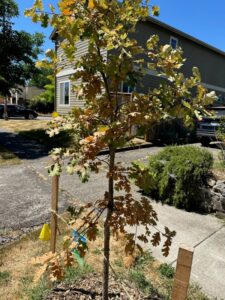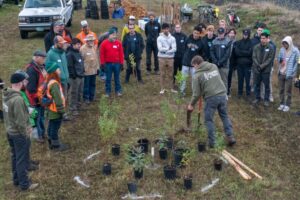Tag: Eugene
Are your trees getting enough water?
Watering tips from the Eugene Team
This July didn’t hesitate to remind us just how hot it can get in an Oregon summer, with five consecutive days with highs over 100° Fahrenheit. And while many of us are lucky to be able to find shelter from a heatwave, trees don’t have that same luxury. For young trees in particular, extreme heat can cause tremendous stress and threaten the trees’ survival.
“It’s around this time every year when we start getting a steady flow of concerns about the well-being of young trees,” says Eugene Director Erik Burke. “Trees can dry out in just a couple days in a heatwave. There are a lot of factors that go into it, including the species and the site conditions.”
Trees that are getting too much water or not enough water can show similar symptoms. Most notably, their leaves will start to brown and curl. In most instances that a tree is getting too much water, it’s because the resident has lawn irrigation systems. It’s more common that a tree is under-watered.
“It can be hard for people to apply enough water,” Erik says. “Sometimes I see people misting the ground beneath their tree with a hose and then walking away. And there wasn’t even enough water to penetrate the soil.”
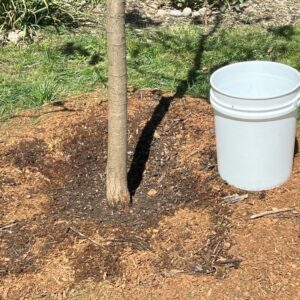
Trees need deep weekly watering during hot dry summer months: 10 to 15 gallons of water around the base of the tree. It’s important to imagine where the roots are. You want the water to be reaching through the soil to the ends of those roots. It’s also good practice to water in the morning or the evening when you’ll lose less moisture to evaporation. A thick layer of mulch will help retain moisture in the soil.
During a heatwave, your tree might need to be watered more often than once a week, but how do you know if it’s time to water? You can test the soil! There are inexpensive soil moisture readers available at hardware stores, or you can use something you have readily on hand, like a pencil or a stick.
“It’s like testing a cake to see if it’s done,” says Taylor Glass, our Eugene Springfield Program Manager. Insert your pencil several inches into the soil. When you pull it back up, if soil has stuck to the pencil then it still has moisture and you don’t need to water just yet. If it comes up dry you can go ahead and water your trees. Different soil types will dry out faster than others, so it’s important to check regularly and get to know your tree’s particular site.
“Some trees will suddenly torch, that is, get really dry and stressed,” Erik says. “As soon as you see that, you just want to water the heck out of it. Every species has a different tipping point.”
Some species like the Oregon ash or California buckeye will call it quits for the year when the soil gets dried out in August and just drop their leaves. When they come back next year they’re totally fine. But other trees won’t survive.
To help new tree owners take care of their trees, Friends of Trees sends out volunteer summer inspectors. For the first three summers of a tree’s life it will get two visits. The inspector will check on the tree’s well-being, look for any issues or concerns, and check the soil to see if there’s enough moisture.
“It’s a really fun role,” Taylor says.” You get to learn about trees while walking or biking around your neighborhood.”
With heat waves becoming more and more common, we need trees and the shade they provide to keep us cool. We need to return the favor and make sure we take care of trees so that they can survive and thrive.
Returning to a Natural Area in Springfield
Can I get a refill?
Next month, volunteers will be planting trees, shrubs, and understory near a major intersection on the Bob Straub Parkway in Springfield. But they won’t be starting from scratch—this location has already been the site for four planting events in the past six years. You’ve heard us say it before at Friends of Trees, we don’t just plant and walk away. But what exactly does that mean? It means post-planting care, stewardship training, and in the case of many natural area plantings like this one, it means infill planting.
Infilling is sort of like refilling, not that this site is empty. Thanks to enthusiastic past volunteers who planted it and neighbors of the planting site who have protected it, it’s already a beautiful spot.
“This is one of our most successful Green Space plantings,” says Eugene Director Erik Burke. “It’s in the floodplain, and it has really good soil. Overall, things are growing really well.”
That doesn’t mean that the site isn’t worthy of some replanting. At natural area plantings like this one, we plant in pods that have multiple levels: trees, shrubs, and herbaceous understory with things like milkweed and camas. At the Bob Straub planting site, a few trees need to be replaced and some of the shrubs and flowers could use some support.
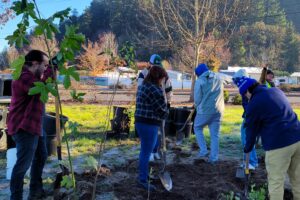
“We really want to create a rich, robust planting area,” Erik says. “It’s so satisfying to create these dense clusters of plants.”
We plant these pods similar to the Miyawaki Method, which aims to mimic how a forest would rebuild itself if people stepped away. It’s all about establishing a community of trees and plants, which is fitting because a community of people plant it, care for it, and benefit from it.
“Like with all of our plantings, it’s important to make sure that they have a lasting impact,” Erik says. “That’s why we return.”
Pedal Power in Eugene
A new E-Bike grant gives our Eugene team even more Pedal Power!
Our Eugene-Springfield team just received an Electric Mobility Grant from the Eugene Water & Electric Board. The team will receive two new electric bicycles to use for pedal powered planting. Our Eugene plantings already feature robust bicycle use and these new e-bikes will expand our plant-by-bike program even more.
“It’ll be great to be able to use these new e-bikes to haul trees at planting events,” says Eugene-Springfield Program Manager Taylor Glass. The team has borrowed e-bikes from partners in the past so they know exactly how useful they can be.
“Eugene has a fair amount of hills,” says Eugene Director Erik Burke. “It can be a fun challenge on a regular bike, but I’ve had to get off to push a bike trailer up a big hill.”
“The e-bikes can go further and up hills and that just opens up more possibilities for where we can plant by bike,” Taylor says. “And it will give volunteers an opportunity to try them out.”
Beyond planting events Friends of Trees staff will be able to use the e-bikes for things like site inspections, outreach events, and pruning. Reducing how often we drive as part of the sustainability goals for Friends of Trees.
“You really get to know the city better when you’re biking through it rather than driving,” Erik says.
Want to get in on the action this season? Check out our planting event calendar. Do you want to step up and lead a planting crew? Crew leader training is November 29th.
The 2023 Season Begins in Eugene
How the Eugene-Springfield team is starting the 2023 season
In Eugene and Springfield, Friends of Trees has been growing a robust community of tree stewards through their community pruning events. They’re about halfway through their slate of seven pruning events, each one with a small but mighty crew of pruners. By keeping these events intimate, each pruner gets plenty of hands-on experience.
“Young tree pruning is the most cost effective thing you can do for an urban forest,” says Eugene Director Erik Burke. “It’s a great experience for volunteers. We have a lot of regulars, and some new folks too.”
The Eugene Springfield team will kick off their season as they always do with another planting along Northwest Expressway on November 4th. This year will be the monumental Phase 10 of this planting project. It’s a prime example of putting trees in places where there’s plenty of room for trees and the benefits they provide. The team is able to plant large species, and also plant shrubs and bulbs to create a multi-level habitat for pollinators and wildlife. As each phase matures it does more and more to clean the air from the expressway and the railroad.
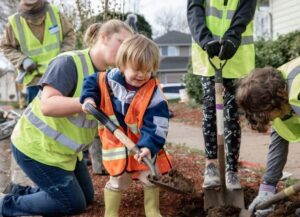
One of the most exciting things happening in Eugene this season will be the expansion of our equity work into high priority neighborhoods. With funding from an EWEB Greenpower Grant, the Bethel, Trainsong, and Far West neighborhoods will each get planting events, increased engagement, and more trees!
“We want to continue focusing our urban tree planting work on equity, sustainability, and resilience,” Erik says. “The Greenpower grant has allowed us to do even more.”
These are just a few of the exciting things happening for our Eugene Team this season. Stay tuned for when we dig in on these topics and more, and visit their event calendar here to join in on the fun!
A Leaflet on Leaflets
If you’ve ever gone on a tree walk with Eugene Director Erik Burke, you’ve heard about some of the nuanced differences among trees that you can study to identify them. One iconic characteristic is always a good starting point: the leaf. Summer is a great time to investigate the myriad shapes that leaves take.

But what exactly comprises a single leaf? A tricky aspect of plant morphology is understanding simple leaves versus compound leaves. A simple leaf is a singular leaf connected by its stem, or petiole, to the branch (like the Oregon white Oak pictured above).
Sometimes what you might think is an entire leaf is actually a leaflet on a compound leaf. Leaflets will all be attached to the main petiole, which is connected to the branch. How can you tell the difference? Look for the bud node, which will appear where the stem connects to the branch, but not where a leaflet connects to the stem.
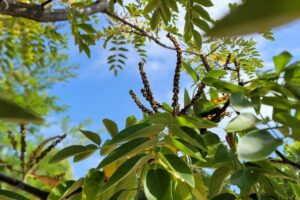
Some compound-leaved trees include golden rain tree, red horsechestnut, yellowwood, Amur maackia (pictured above), and Kentucky coffee tree (pictured below). The Kentucky coffee tree has double compound leaves. That means that their leaflets have leaflets. Their leaflet branches can have 40 leaflets!
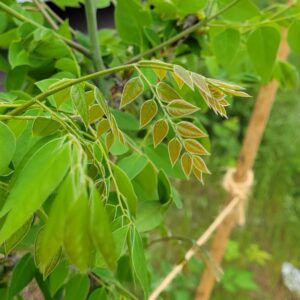
Some other common trees that folks may know that have compound leaves include ashes, buckeyes, locusts, walnuts, and the infamous tree of heaven. Becca and Erik in the Eugene office sometimes compete at events for who can find the tree of heaven leaf with the most leaflets. Becca currently has the record with 49.
One of the best times to get up close and personal with a tree’s leaves is when you’re pruning. Our Eugene-Springfield team is hosting community printing events August through October. Details here.

